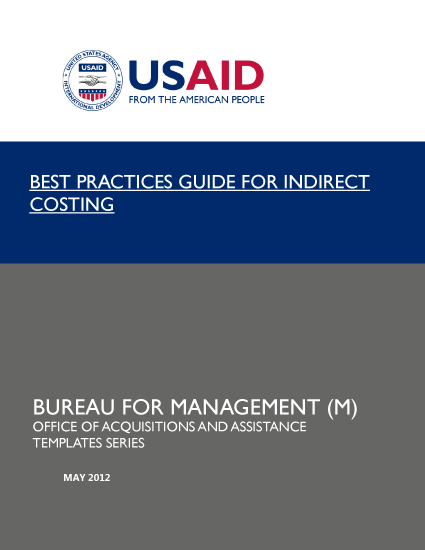![]() (441k) ADS Reference 300mah
(441k) ADS Reference 300mah
Best Practices Guide for Indirect Costing
Mandatory Reference for ADS 300 – Acquisition & Assistance
Partial Revision Date: 11/17/2014
Responsible Office: M
File Name: 300mah_111714
Overview
The purpose of this guide is to present best practices related to indirect costing. It defines indirect costs and describes how USAID can reduce indirect costs it pays under its awards, both acquisitions and assistance.
What are indirect costs
Indirect costs are costs which cannot be directly identified with a single contract or grant. The indirect costs are applied equitably across all of the business activities of the organization, according to the benefits each gains from them. Some examples of indirect costs are office space rental, utilities, and clerical and managerial staff salaries. To the extent that indirect costs are reasonable, allowable and allocable they are a legitimate cost of doing business payable under a U.S. Government contract or grant.
How rates are established
Responsibility for negotiating indirect cost rates with organizations doing business with the U.S. Government is specifically assigned. Each organization negotiates its indirect cost rates with one government agency which has been assigned cognizance. Usually the cognizant government agency is that agency which has the largest dollar volume of contracts with the firm or organization. The resulting Negotiated Indirect Cost Rate Agreement (NICRA) is binding on the entire government. The NICRA contains both final rates for past periods and provisional (billing rates) for current and future periods. A procurement office may not negotiate a different rate or base of application for an individual cost reimbursement contract or program. The provisional (billing) rate is established for use in reimbursing indirect costs under cost-reimbursement contracts and grants until a final rate can be established. The billing rate may be revised by the cognizant agency to prevent substantial overpayment or underpayment in the event of a significant change in the firm's business volume, but should not be revised during individual contract or grant negotiations. A final indirect cost rate is established after the close of the contractor's fiscal year and once established is not subject to change.








Comment
Make a general inquiry or suggest an improvement.